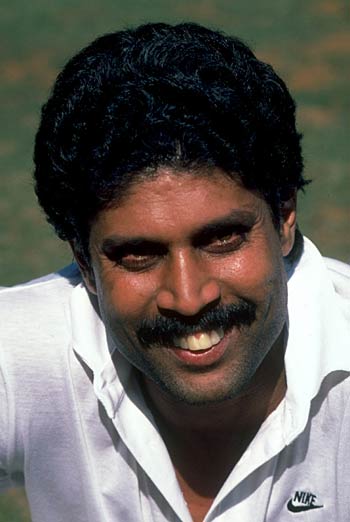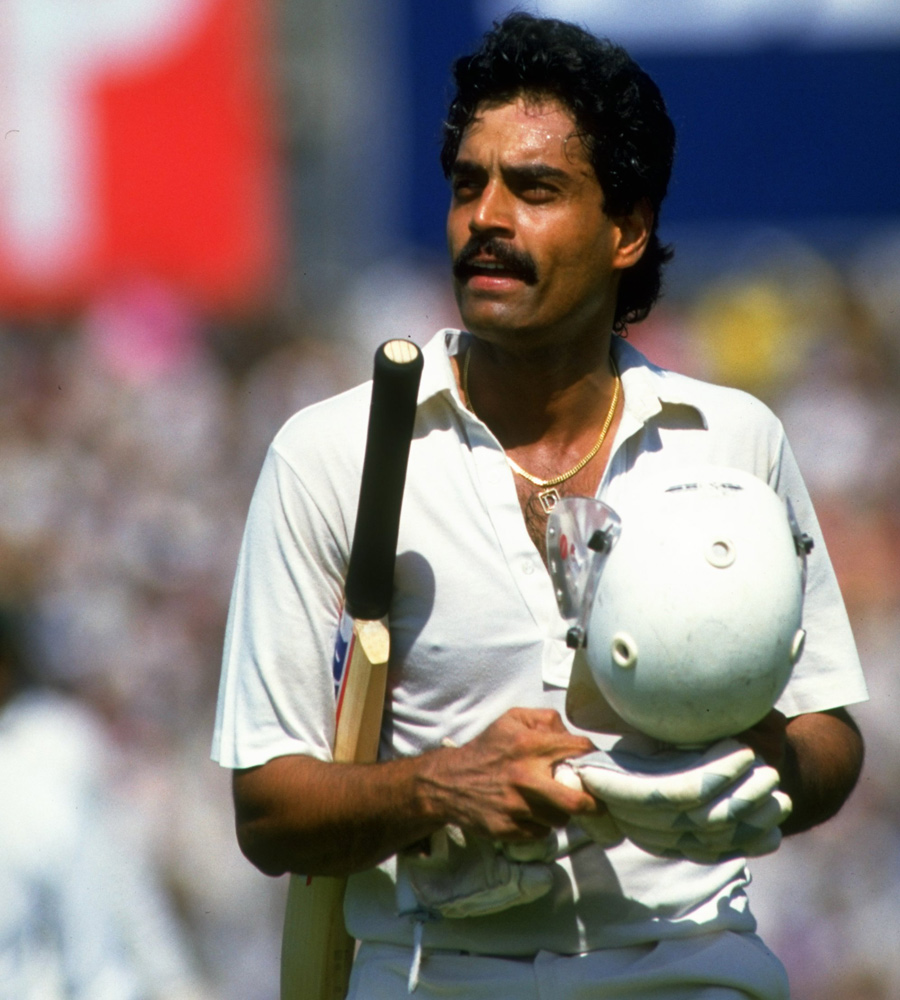The Indians in England, 1986
G.W.
|
|

|
As the Indians began their tour in cold, rainy weather in the West Country, two questions came to mind. Why were they filling the first half of a twin-tour summer when, having toured first in 1982, they could have followed New Zealand in 1986? And could their bowlers, on the evidence presented, bowl England out twice to win a Test match?
The answer to the first question was that it was the choice of India's Board of Control. With two tours of India scheduled for 1986-87, they wanted their international players fresh at the start of the season rather than returning from a tour of England. While sensible, this none the less condemned Kapil Dev's team to the colder, more unsettled half of the English season. And the wisdom of it was called into question when India went into the first one-day international, having lost a third of their playing time to the weather. Furthermore, it meant there was no place in the touring team for the leg-spinner, Laxman Sivaramakrishnan, whose art would be nullified by wickets still not hard.
India won the first one-day international; they won the Texaco Trophy; and they beat England in the first Test, so winning their second Test in England and their first at headquarters. In doing so they answered, convincingly, the second question, and they did so again at Headingley, embarrassingly, dismissing England for 102 and 128.
The turning-point came at Northampton, where Kapil Dev, Roger Binny and Chetan Sharma bowled the county side out for 118. This success, and especially that of Kapil who, moving the ball from leg to off or cutting it back, took four wickets in eight balls, brought home to the Indians the vulnerability of English batsmen in English conditions. Subsequently, in the Test series, their seam bowlers adhered to the traditional virtues of line and length, while the selection of two left-arm spinners reinforced the strategy of attacking the England batsmen on and outside off stump. Consequently, players programmed by limited-overs cricket to working the ball to leg were forced to adjust their method. And when the conditions encouraged movement in the air or off the pitch, as they did for the Indian bowlers in all three Tests, the deficiencies in English batting techniques were exposed.
Chetan Sharma, a pocket battleship of a fast-medium bowler, took most wickets on tour and in the Test, his six for 58 in England's second innings at Birmingham giving him ten wickets for the match. Aggressive and volatile, he none the less bowled with great control, and the ball that came back from outside off stump found more than one open gate. Binny, whose medium-pace bowling had been a leading factor in India's World Cup success in 1983, put his back into his work more as the tour progressed and gained an extra half yard of pace without any loss of accuracy. He saved his best for the Test matches, as indeed he seemed to save his best catches for his own bowling. Manoj Prabhakar offered little more than swing, obtaining little movement off the pitch, and when Chetan Sharma was ruled out of the second Test by injury, the Indians called up Madan Lal from the Central Lancashire League. It was a wise decision.
Maninder Singh, a veteran of fifteen Tests at the age of twenty, was not expected (by English commentators) to have a role in the Tests yet played in all three and topped India's averages. He turned 21 on tour, by which time his control of flight and spin, as well as his colourful patkas, had revived memories of Bishan Bedi and set India on the way to a historic win at Lord's. Shivlal Yadav bowled his off-spin well, and tactics rather than form kept him out of the Test team. By way of compensation he was rewarded with career-best figures of six for 30 at Taunton, where Mohammad Azharuddin held five catches close to the bat. The enthusiastic fielding and throwing of this Indian side contributed largely to its success.
|
|

|
While the technique of England's batsmen was found wanting, that of the Indians was not. Krishnamachari Srikkanth, by the impulsive nature of his game, always gave bowlers a chance, but if Sunil Gavaskar failed to make the same impact as on his four previous Test-match tours, that owed more to his own approach than to any lessening of technique. So often in the past the main course, Gavaskar preferred this time to be a lively hors d'oeuvre, whetting the appetite for the batting that followed.
In Dilip Vengsarkar, India had the batsman of the series. At Lord's and at Headingley, his hundreds were the platform from which India pushed for victory. In both innings of both Tests he top-scored for India, was rarely forced to play a false stroke, and made every movement elegant. His 126 not out in the first Test was his third in a Test match at Lord's, unique for an overseas player, and his achievements are recognised earlier in the Almanack.
On either side of him, India could bat the experienced Mohinder Amarnath and their exciting new talent, Azharuddin. At Lord's, the former threatened for a time to emulate his performance at Northampton the previous week by scoring a hundred before lunch, and although injury kept him from the second Test, he enjoyed a good tour and a good series. Azharuddin, on his first tour of England, scored most runs for the Indians and was one of three to average more than 50. Fluent and wristy, he looked happiest early on when flicking the ball off his legs or playing off the back foot, but by the tour's end he was revealing a more all-round game. His concentration, apt to oscillate, also improved.
Yet the real strength of India's batting was its depth. In the Test matches there was no tail to speak of. Kapil Dev, with the responsibility of the captaincy and of spearheading the bowling, played his most exciting innings away from the Test arenas. His confidence and his personality flowered after the win at Lord's. Ravi Shastri, his vice-captain, looked to own his reputation as a world-class all-rounder but gave little more than glimpses of it as either batsman or slow left-arm spinner. Mature and experienced for his 24 years, he led the side capably in Kapil's absence.
Both wicket-keepers served India well. Each averaged around 40 and kept to a high standard. Kiran More received the nod for the Tests after the ebullient Chandrakant Pandit had played in the one-day internationals. And when Amarnath was unfit for Headingley, Pandit played as a batsman ahead of Lamba and Patil. An opener in the Srikkanth mould, flashy but impermanent, Raman Lamba batted most attractively in the Indians' victory over Yorkshire at the end of the tour and stated firmly his potential. But Sandeep Patil, a star of the 1982 side, seemed to have lost the confidence that made him such an exciting batsman.
A happy team spirit prevailed throughout the tour, fostered by a genial but firm manager, Raj Singh. Mr Prabhudesai, from the Bombay Cricket Association, was assistant manager. A winning team is usually a happy one, but it was greatly to India's advantage, and to the credit of the players concerned, that during the Indians' tour of Australia, Kapil Dev and Gavaskar had formed a bond of friendship, the outcome of which was to be India's most successful tour of England.
Match reports for
Tour Match: Duchess of Norfolk's Invitation XI v Indians at Arundel, May 4, 1986
Report |
Scorecard
Tour Match: Worcestershire v Indians at Worcester, May 6-8, 1986
Report |
Scorecard
Tour Match: Surrey v Indians at The Oval, May 15, 1986
Report |
Scorecard
Tour Match: Hampshire v Indians at Southampton, May 17-19, 1986
Report |
Scorecard
Tour Match: Kent v Indians at Canterbury, May 21-23, 1986
Report |
Scorecard
1st ODI: England v India at The Oval, May 24, 1986
Report |
Scorecard
2nd ODI: England v India at Manchester, May 26, 1986
Report |
Scorecard
Tour Match: Northamptonshire v Indians at Northampton, May 31-Jun 2, 1986
Report |
Scorecard
1st Test: England v India at Lord's, Jun 5-10, 1986
Report |
Scorecard
Tour Match: Leicestershire v Indians at Leicester, Jun 14-16, 1986
Report |
Scorecard
2nd Test: England v India at Leeds, Jun 19-23, 1986
Report |
Scorecard
Tour Match: Somerset v Indians at Taunton, Jun 28-30, 1986
Report |
Scorecard
3rd Test: England v India at Birmingham, Jul 3-8, 1986
Report |
Scorecard
Tour Match: Yorkshire v Indians at Scarborough, Jul 12-14, 1986
Report |
Scorecard

